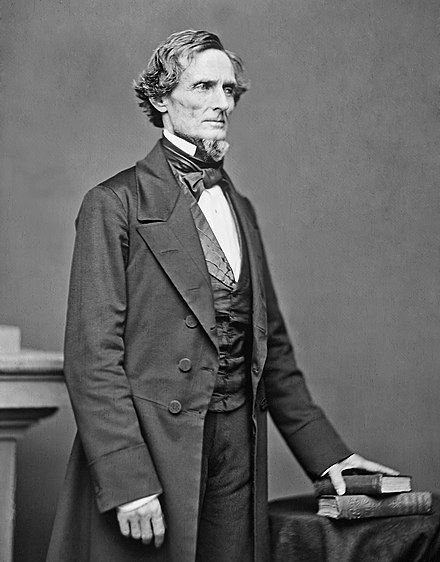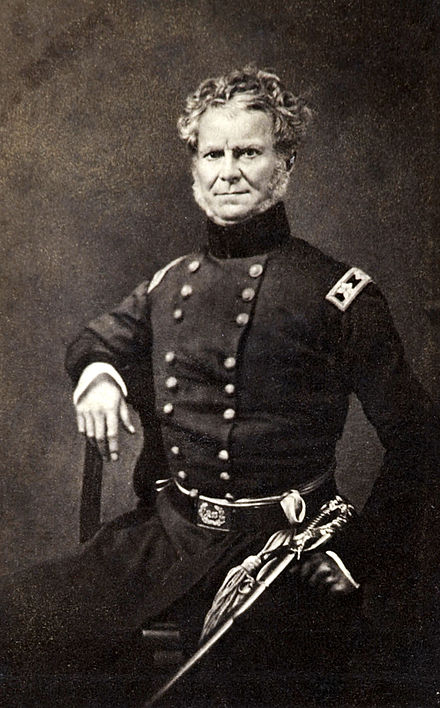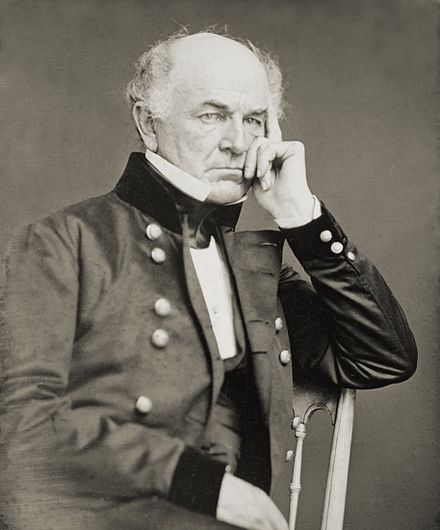Eggnog Riot
The Eggnog Riot, sometimes known as the Grog Mutiny, was a riot that took place at theUnited States Military Academy in West Point, New York, on 24–25 December 1826. It was caused by a drunken Christmas Day party in the North Barracks of the Academy. Two days prior to the incident, a large quantity of whiskey was smuggled into the academy to makeeggnog for the party, giving the riot its name. The riot eventually involved more than one-third of the cadets by the time it ceased on Christmas morning. A subsequent investigation by Academy officials resulted in the implication of seventy cadets and the court-martialing of twenty of them and one enlisted soldier. Among the participants in the riot—though he was not court-martialed—was future Confederate States President Jefferson Davis.
Background
The large number of small dairy farms in Colonial America in the early 19th century made milk, cream, and eggnog more accessible to the American public. George Washington drank eggnog that contained not only rum, but also significant amounts of sherry, brandy, and whiskey.
In 1817, Sylvanus Thayer took command at the United States Military Academy. By 1826, the Academy had 36 men serving as faculty and staff with four recognized departments – mathematics, engineering, natural philosophy (now the physics, chemistry and life sciencesdepartments , and military tactics. Alcohol possession at the Academy was prohibited along withdrunkenness and intoxication, both of which could lead toexpulsion. Tobacco use and gambling could lead to demerits, minor incarceration, or a loss of privileges. By 1826, concern had been raised that drinking was starting to get out of hand among the 260 cadets at the Academy. The cadets were informed that, due to the alcohol prohibition on the site, their Christmas eggnog would be alcohol-free, prompting the decision to smuggle liquor into the academy to add to the eggnog.
Timeline of events 22 December 1826
20:50 – 22:15
At Martin's Tavern, cadets William R. Burnley (Alabama), Alexander J. Center (New York), and Samuel Alexander Roberts (Alabama) almost got into a fight with the proprietors of another tavern concerning getting whiskey back to West Point. Private James Dougan, the duty security guard, agreed to let the three cadets take a boat across the Hudson tosmuggle the whiskey. The cadets planned to purchase a half-gallon of whiskey as an alcohol base for the eggnog party that would take place in the North Barracks two nights later. Phillip St. George (Virginia) was the 24-hour duty cadet guard of the day. Burnley, Center, and Roberts successfully obtained two gallons of whiskey, smuggling them into North Barracks Room #33. Cadet T. M. Lewis (Kentucky) also returned with a gallon of rum from Benny's Tavern to North Barracks Room #5.
At Martin's Tavern, cadets William R. Burnley (Alabama), Alexander J. Center (New York), and Samuel Alexander Roberts (Alabama) almost got into a fight with the proprietors of another tavern concerning getting whiskey back to West Point. Private James Dougan, the duty security guard, agreed to let the three cadets take a boat across the Hudson tosmuggle the whiskey. The cadets planned to purchase a half-gallon of whiskey as an alcohol base for the eggnog party that would take place in the North Barracks two nights later. Phillip St. George (Virginia) was the 24-hour duty cadet guard of the day. Burnley, Center, and Roberts successfully obtained two gallons of whiskey, smuggling them into North Barracks Room #33. Cadet T. M. Lewis (Kentucky) also returned with a gallon of rum from Benny's Tavern to North Barracks Room #5.
23 December 1826
07:00
Thayer met with George Bomford (New York) and Robert E. Lee (Virginia). Bomford was questioned about his parental correspondence by Thayer while Lee questioned Thayer about trigonometry problems for artillerygunnery. Classes and barracks
Thayer met with George Bomford (New York) and Robert E. Lee (Virginia). Bomford was questioned about his parental correspondence by Thayer while Lee questioned Thayer about trigonometry problems for artillerygunnery. Classes and barracks
inspections continued as usual that day.17:45
A Christmas party took place at Thayer's residence at which wine was served. Reverend Charles McIlvane, the Academy chaplain, was among the attendees. During the party, a conversation ensued between Thayer and MajorWilliam J. Worth, the Commandant of cadets, about Jefferson Davis' (Mississippi) disciplinary problems Entertainment was provided by the West Point band. The party ended at 21:30.
18:00
Four cadets, Walter B. Guion (Mississippi), Davis, John Stocker (Pennsylvania), and David Farrelly (Pennsylvania), met at Benny Haven's tavern. Most of the discussion was about everyday life among the cadets. They left before Academy quartermaster Aeneas Mackay arrived.
Four cadets, Walter B. Guion (Mississippi), Davis, John Stocker (Pennsylvania), and David Farrelly (Pennsylvania), met at Benny Haven's tavern. Most of the discussion was about everyday life among the cadets. They left before Academy quartermaster Aeneas Mackay arrived.
Meanwhile at the North Barracks, cadets were planning the party. Preparations included stealing bits and pieces of food during their visits to the mess hall. During this time, cadets residing in the South Barracks found out about the North Barracks' planned Christmas party.
24–25 December 1826 22:00 to 04:15
Nathaniel Eaton (Massachusetts) was the cadet in charge of theexternal post of the North Barracks. CaptainEthan Allen
Hitchcock, a faculty member in military tactics, was also stationed in the North Barracks. Eaton and Hitchcock met and discussed the smuggled liquor in the North Barracks.
The eggnog party started among nine cadets in North Barracks Room No. 28. Numerous cadets appeared as the party progressed, while another party began in Room No. 5, mentioned by seven cadets including Davis. Farrelly went again to North's or Havens and returned with another gallon of whiskey early on Christmas morning.
Cadet Charles Whipple (Michigan Territory), the divisionsuperintendent during the first part of the incident, went to North Barracks Room No. 5 at 02:00 after hearing a commotion, interrupting a round of singing among eight cadets, including Davis. Whipple returned to his room after a verbal exchange with Davis and the other cadets. Hitchcock made
another patrol around the barracks at 03:00.Lieutenant William A. Thornton was asleep while the events unfolded.
another patrol around the barracks at 03:00.Lieutenant William A. Thornton was asleep while the events unfolded.
By 04:00, voices from the floor above Hitchcock were loud enough to cause the faculty member to investigate Room No. 28, where Hitchcock knocked on the door and found six cadets drunk from the eggnog, as well as two others sleeping on a bed. Hitchcock ordered two of the cadets back to their rooms. After they left, Hitchcock woke the two sleeping cadets and ordered them to leave as well. Then he confronted Cadet James W.M. "Weems" Berrien (Georgia), who responded with equal force. Hitchcock read the Riot Act to the residents of the room for possessing alcohol on the premises. The captain left the room at 04:15. Berrien began verbalising his rage toward Hitchcock, which led William D.C. "Billy" Murdock (District of Columbia) to lead an effort to organize a riot against Hitchcock..
25 December 1826 04:30 to 06:05

Jefferson Davis as President of the Confederate States of America in 1861. Davis was among the seventy cadets who took part in the Eggnog Riot of 24–25 December 1826.
Hitchcock went down to his room to sleep. Three times he heard knocks on the door only to find no one there. After finding another cadet drunk, Hitchcock saw Davis head over to Room No. 5 where thirteen cadets were partying. Davis, seeing Hitchcock's arrival, warned the other cadets. The captain entered the room, ordering one of the cadets to open up another cadet's footlocker, but the cadet refused. Hitchcock ordered no more disorder, left the room, and started looking for Thornton around 04:50.
Meanwhile Thornton had strolled the North Barracks between 21:00 on the 24th and 02:00 on Christmas Day observing the ongoing partying, before going to sleep at 02:00. He was awoken by loud yells and, once out of his room, was attacked by two cadets. Thornton then put cadet William P.N. Fitzgerald (New York) under arrest for brandishing a weapon. Fitzgerald retreated from Thornton, then told two cadets in Room No. 29 about the arrest.
At this point, noises erupted from the South Barracks which distracted
Thornton. While going to investigate that commotion, Thornton was knocked out by Roberts, who had been ejected from Room No. 28 by Hitchcock earlier that evening.[33]
Thornton. While going to investigate that commotion, Thornton was knocked out by Roberts, who had been ejected from Room No. 28 by Hitchcock earlier that evening.[33]
Davis was asleep, but other cadets went looking for Hitchcock. Three other cadets were discovered by Cadet James G. Overton (Tennessee), a relief sentinel and not involved in the parties, and questioned about their actions. They gave a drunken explanation about needing drums and a fife.
At around 05:00, Hitchcock found another inebriated cadet wandering the academy.
By this point, several window panes had been broken. Hitchcock returned to the room where he was staying, No. 8. Several cadets then attacked his door, Guion drawing his pistoland firing a shot into the room. Hitchcock opened the door and yelled at the cadets to stop. The captain then began arresting cadets.
Hitchcock ordered Eaton to find Worth's headquarters. Overton asked Hitchcock to find Thayer and Hitchcock replied "No, Mr. Overton. Fetch the 'com'(Commandant Worth) here!" Several of the drunken cadets thought Hitchcock had stated the Bombardiers would be the ones to quell the riot, using heavy weapons, causing several cadets who were not drunk to take up arms in defence of the North Barracks. Thayer had been awoken at 05:00 by the sound of drums. He ordered his aide, Patrick Murphy, to get Major Worth because of what he could hear going on in the North Barracks.
Hitchcock continued restoring order in the North Barracks, getting into a fight with Cadet Walter Otey
Virginia). Thornton awoke from the stairway where he had been knocked out and returned to his room. Hitchcock greeted him in his room at 05:45. By 06:00, other cadets who were not drinking were also involved in restoring order. The main rioters were attempting to recruit other cadets, but with no success.
Virginia). Thornton awoke from the stairway where he had been knocked out and returned to his room. Hitchcock greeted him in his room at 05:45. By 06:00, other cadets who were not drinking were also involved in restoring order. The main rioters were attempting to recruit other cadets, but with no success.
Overton could not find Cadet Eaton, who was checking the South Barracks, but did find Major Worth. Hitchcock met Worth and told him what had transpired. By this time, Thayer's aide had arrived in the North Barracks' guardroom. The Second Artillery had arrived at the North Barracks by the time of Reveille at 06:05.
06:05–18:30
Reveille sounded at 06:05, along with gunfire, the sound of glass breaking, profanity by cadets, cries of
pain, and threats on Academy officials. North Barracks residents who were not drunk from the eggnog were appalled by the damaged property. Cadets in the South Barracks were well rested, while other cadets in the North Barracks were disheveled. Some of the cadets remained in their rooms drinking, although some appeared in parade formation despite being drunk. Worth met with Superintendent Thayer after the first formation to discuss what had happened in the North Barracks the previous evening. Thayer instructed Worth to get the officers into the North Barracks and restore order.
pain, and threats on Academy officials. North Barracks residents who were not drunk from the eggnog were appalled by the damaged property. Cadets in the South Barracks were well rested, while other cadets in the North Barracks were disheveled. Some of the cadets remained in their rooms drinking, although some appeared in parade formation despite being drunk. Worth met with Superintendent Thayer after the first formation to discuss what had happened in the North Barracks the previous evening. Thayer instructed Worth to get the officers into the North Barracks and restore order.
Captain Mackay, Academy quartermaster, took down details of the damages to the property at North Barracks so repairs could take place in the following days. Many cadets who were drunk made it to company roll call at 06:20, though they were subdued. The mutiny officially ended when Cadet Captain James A.J. Bradford (Kentucky) called the corps to attention and dismissed them from the mess hall after breakfast.Chapel formation took place after breakfast, followed by two hours of service, with most of the drunk cadets still recovering.
Thayer was advised by Worth regarding the events at North Barracks. Captain Hitchcock and Lieutenant Thornton were bruised, while several cadets suffered minor injuries, and Fitzgerald suffered a hand injury. Worth told Thayer that between fifty and ninety cadets had been involved in the mutiny. Later that day, Thayer met with Gouverneur Kemble, an-ordnance manufacturer in Cold Spring, New York, to discuss different items, including the events at West Point. Kemble asked Thayer what he would do about the misconduct, to which Thayer replied he did not know.


No comments:
Post a Comment